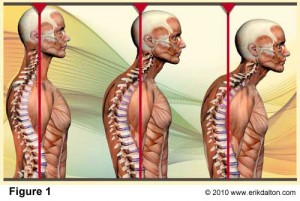Life is a constant battle against gravity. You can't get away from it on this planet and it pulls us down 24 hrs. a day. We get tired or don't exercise enough and gravity pulls us down. We sit too much and gain a little extra weight and in turn gravity isn't kind to our joints. It's true what you've heard: posture is extremely important; it is your chief combatant against gravity. And, knowing what good posture is, how to train and obtain it is even more important. Good posture has everything to do with joint health, organ efficiency, proper breathing, and even looking younger! Everybody wants it and it's pretty easy for most people to assume an ideal posture standing in front of a mirror, but how often do you actually do that? We rarely function in a static perfectly aligned skeletal position. Instead, we are constantly on the move, or as one of the chief detriments to posture, sitting, watching tv, in a car, or behind a desk with our hands slouched over a computer. The key is taking time to figure out what ideal posture is for you, how far you and your skeleton are way from it, and implement measures to correct and maintain it.
Posture is pretty much defined as 'the position of the body', but it involves a lot more behind the scenes than simply standing up straight. Simply put, the human skeleton is dependent upon the brain and spinal cord to relay precise nerve conduction signals to fire muscle, which in turn engages tendon to pull on bone and move or stabilize joints. All of these systems need to be challenged through conscious exercise to be able to acquire alignment at any given time and maintain it even when you're not thinking about it.
House of Cards: The Collapse

As I eluded to above, extra weight is extremely detrimental to posture and worse. Not only does the force of gravity
act through joints to put extra pressure on them, extra body mass can shift your center of gravity (mass) from an ideal alignment changing your perception of balance and your ability to control your body while in motion making simple walking a challenge and falling a possibility. Even in static stance, your body is working so hard that eventually there's going to be a collapse. And you've all seen it: the foot [arch] collapses, knees angle inward, hips rotate internally, the pelvis tilts posteriorly taking the lumbar spine out of natural curvature creating unwanted pressure on discs, a rounded upper back follows with internally rotated shoulders and pronated forearms, the neck hyperextends to keep the eyes forward. This collapse, or total body pronation, is a bad deal if around too long. Your body becomes accustomed to it and arthritis sets in. Treating the symptoms with orthotics is a cakewalk compared to neck fusion or a knee replacement. Get ahold of effective eating habits and consistent exercise to drop those unwanted pounds.
Detriments to Posture
Bad Exercise Habits
Surprisingly enough, one of the biggest detriments to posture I've seen over my years in the fitness business is choosing the wrong exercises. Isn't that a kick in the head! You exercise to get stronger and end up with bad posture. Or, even worse, being assigned the wrong exercises by a trainer or therapist and end up hurt. So many of your so called 'gold standard', 'handed down from generations of gym rats' exercises (bench press, tricep dips, pulldowns behind head, deep knee stuff), are putting joints, tendon, cartilage, menisci, and ligaments in precarious positions leading to wear and tear/injury and contributing to bad posture.
Not Performing Essential Exercises
Pulling backward to offset the constant forward pull of gravity should be in everyone's exercise strategy. Exercises like reverse flys, seated rows, external rotator cuff, triceps, deadlifts, and back extensions are prime examples. AND, manipulating the type or direction of resistance to perform the same exercise is a great strategic option. A cable system or rubberized tubing are great examples.
Benefits to Posture
Center of Gravity
Stand sideways in front of a mirror and see how far your ear is forward of your shoulder and if a rounded upper back is prevalent, or your pelvis is tilted forward. Have someone else assess.The body's natural plum line intersects the ear lobe, center of the shoulder joint, hip joint, the knee, and into the ankle. Many times with clients, teaching them how to draw the neck/chin backward to see where the plum line begins is actually an exercise.
Get Up and Move
The human body does not like to sit folks. In fact sitting places many more times the compressive forces on the lumbar spine than standing. Even at work or on a flight, take the time to get up, walk around and swing your limbs.
Swing 'em
Explore [full] ranges at each joint each day. You know the saying: 'use it or lose it.' Make a habit of swinging straight arms behind body to overhead, from side to overhead, and across the midline (all 3 planes). Same thing with legs, front-back, side-side, rotation.
Strengthen the Anti-Collapse
Most weight room exercises involve training what you can see in the mirror and what's most common: bench press, biceps, etc. You've all seen the guy who can bench press 315# but is internally rotated at the shoulders with palms facing backward. In reality, it's the muscles on the back side of the body that set good posture and make the pecs and shoulders look more prominent. Selecting exercises that reinforce or improve posture, and focusing on alignment, positioning, and stabilization before applying any type of resistance to the human body throughout the entire exercise session are important considerations. Pulldowns, Rows, Reverse Flys, External Rotation, etc.
 Keep it upright!
Keep it upright!